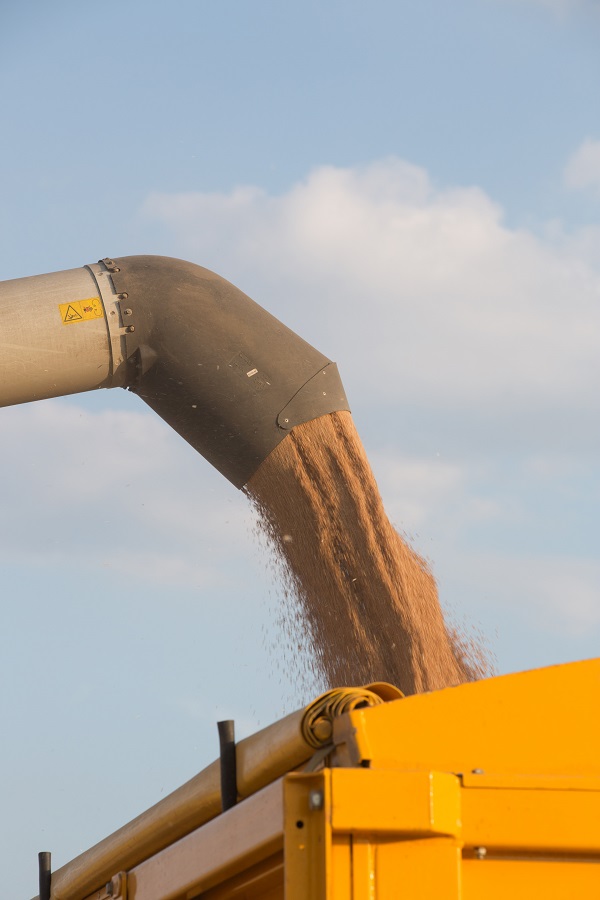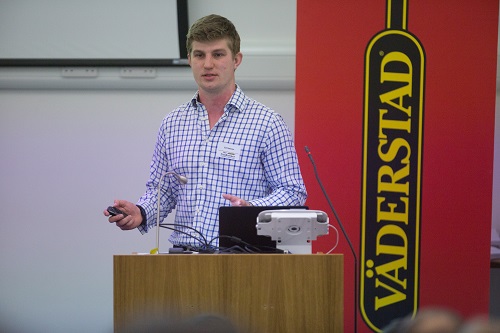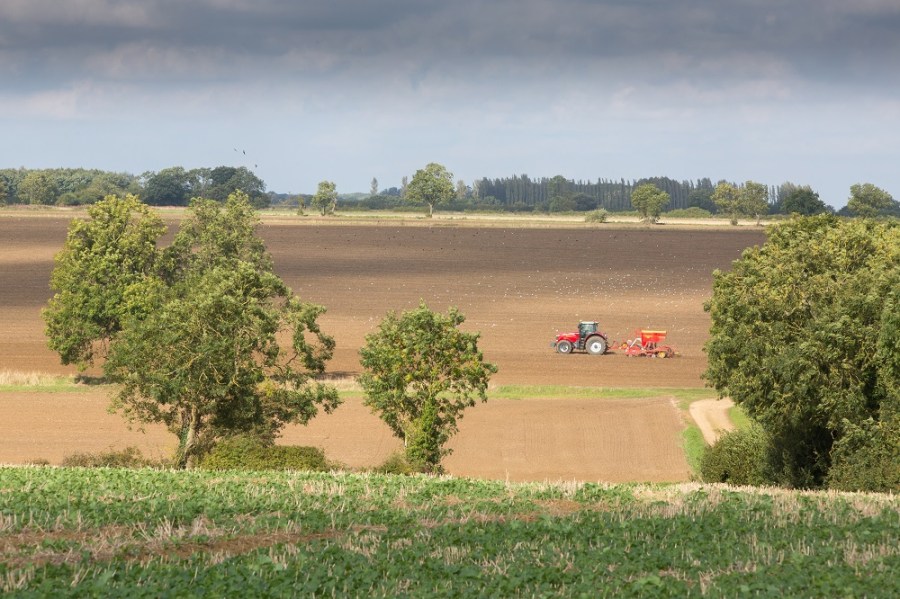Grab the opportunities that Brexit has to offer and look forward to the future, even if that means the loss of subsidies and a re-structuring of your businesses. CPM reports from a recent conference, organised by Väderstad.
There’s so much opportunity for the hungry.
By Louise Impey
Farming should be able to stand on its own two feet and not rely on subsidies or diversified business activities to thrive, believes one young Norfolk farmer.
While any change means that there’ll be a few years of pain, the post-Brexit farming landscape is a once-in-a-lifetime opportunity for those with hunger and enthusiasm for the challenge, says Ed Salmon of NE Salmon, near Dereham.
He farms almost 2000ha on a mixture of owned and contracted land, and sees plenty of reasons for optimism about the years ahead, even as subsidies reduce or are removed.

Yield is king, so variable costs aren’t where savings will be made.
“Our aim is to work towards being able to run our business without the need for subsidy,” he says. “Providing we can continue to adapt and change, there’ll be a good future for farming.”
His family has been based at Hyde Hall, Great Fransham since 1955, when the farm was just 81ha. Today, the business comprises the home farm and four contract farms, totalling 1960ha of cropped area, together with 14,000t of grain storage.
With a wide range of soil types – from chalky boulder clay to blowing sand – the farm has experimented with various crops over the years, but has now moved away from growing specialist, minor crop species such as asparagus, daffodils and blackcurrants.
“While we’ve some land suitable for these niche crops, they all have their challenges,” he says. “They required time spent on marketing and dealing with the public – things which aren’t our natural strengths.”
They also involved expensive, specialist machinery, additional management time and proved to be inefficient unless large areas were grown.
“Unfortunately, too many of them were a nuisance when we were busy with our mainstream crops. And the chemical options for them were very limited, and getting even fewer.”
Today, his focus is to play to the strengths that the farm and its management team has, so that he can harness his passion for farming.

Ed Salmon is aiming to work towards being able to run his business without the need for subsidy.
Soil structure, timeliness, rotation and agronomy are all important cornerstones of the business, which has four full-time staff.
“We look at the capabilities of the soil first,” he reveals. “We plan to keep increasing our yields and make the most of vertical integration wherever we can, getting closer to the consumer by growing human consumption and seed crops on contract.”
As a result, the current system at N.E.Salmon is based on a nine-year rotation, mainly growing cereals and herbage seed. On the contract farms, the rotations are five or six years, depending on the crops being grown, the weed control challenges and suitability of soil type. To his mind, anything less than five years isn’t a rotation.
“On the light contract-farmed land we have potatoes and maize in a 12-year rotation, helping with PCN control to futureproof the crop as well as reducing the impact of soil damage.”
Ed Salmon hasn’t experienced the yield plateau that others have seen over the past decade, with winter wheat yields rising steadily from 8.7t/ha to 10.8t/ha.
“For us, yield is king,” he stresses. “We believe in investing in our crops to get the best from them. So variable costs aren’t where we’ll be making savings – cutting our input use would be a false economy.”
He accepts that the loss of subsidies would be a short-term blow, but he has a vision of how his business can respond so that every part of it’s performing.
“The focus will be on fixed costs. The UK has much higher fixed costs than other wheat producing countries, so it’s something that we can all improve on.”
As a result, he’s been scrutinising his power/machinery and labour costs, looking for ways to do more with less through better machinery efficiency, a wider rotation and taking on more land of the right type.
“Wherever possible, we’ll be working with our neighbours to share kit and labour, making use of joint initiatives and efforts.”
Having counted 64 different items of kit, ranging from small to large, in the farm’s workshop, Ed Salmon is determined to reduce this tally and streamline the fleet – releasing capital and bringing down the depreciation bill.
“Anything that hasn’t been used in the past 12 months will be sold. There’s too much equipment on the farm.”
He’ll also be making good use of benchmarking, to see how his costs compare with those of similar businesses, but will only use direct drilling in an opportunistic fashion, if conditions allow, to reduce establishment costs.
“On our soil type, it’s not a viable, reliable system,” he notes.
Otherwise, he plans to keep increasing yields and employ forward marketing strategies, to try to even out the volatility that farm businesses are subject to.
“We’re tapping into farmer-based activities, such as the YEN network and the Monitor Farm programme, to learn from others and question our way of doing things.”
A 12m Controlled Traffic Farming system was introduced in 2016, so that he could reap the benefits of improved timeliness, fuel savings, better soil health and reduced cultivations.
“It’s early days, but other businesses have seen fuel savings of up to 50%. We’re aiming to make fewer passes at wider 12m widths. With our track-based system we haven’t needed to subsoil for ten years, but our speed of operations and timeliness should get better.
“We’re only trafficking 13% of the field, rather than the 80%+ that random trafficking involves.”
Initial trial results indicate that yields may rise, with the greatest increases coming on the heaviest land.
Ed Salmon’s final point is that post-Brexit there’ll have to be some adjustments, both to farmer expectations and to the economics of growing crops. “Rents will have to come down and machinery prices, which have rocketed recently, will need to be re-considered.
“But there’s so much opportunity for the hungry – it’s an exciting time to be in farming.”
New Zealand points to a productive path
The loss of subsidies in 1984 was the single best thing to happen to New Zealand’s agricultural industry, says kiwi fruit grower and consultant Nick Brookes, who farms on the Canterbury Plains.
Prior to that, production was supported heavily with nearly 30 different subsidies being in action, supplying 40% of a farmer’s income, compared with just 2% today.
“We had minimum prices for wool, beef, sheep, grain and dairy products,” he recalls. “There were also fertiliser, irrigation, transport and land-development subsidies, along with income support, tax relief and free government services.”
However, productivity was stagnating, as the focus was on making subsidies rather than making money, he reveals. “Farmers were happy, but inefficient.”
The sudden removal of all production support and export incentives was a tough time, acknowledges Nick Brookes, which resulted in a small number of farms going out of business.
“Unemployment benefits were made available to those below the poverty line and grants were paid to farmers who had to leave the land. Initially, fertiliser and pesticide use fell by 50% and land values plummeted, but they recovered over time.”
However, it also spurred farmers on – business efficiency was reviewed and the diversity of agriculture increased. “It was how the growth in kiwi fruit and avocadoes came about. Meanwhile, some farmers took the opportunity to get bigger.”
In general, the farming industry adapted quickly, becoming more diverse and productive, he notes.
“It restructured and explored new markets. There was a significant change in attitude and farmers became earlier adopters of technology and innovation.”
While there was huge investment by private companies into agriculture, the government advisory service went from being free to the user having to pay. As a result, levy organisations such as FAR (Foundation for Arable Research) took over previous government research and used UK research findings and genetics to boost productivity.
“Today, agriculture is larger than it was in subsidy days. New Zealand is the biggest exporter of white clover and carrot seed in the world.”
Irrigation has been key to this success, points out Nick Brookes. “It was the turning point. While we get plenty of rainfall, its timing can’t be relied upon. In New Zealand, you’re only ever two weeks away from a serious drought.”
Adopting irrigation resulted in higher yields, better consistency, greater crop diversity and more sustainable production. “Returns went up, land prices rose and vegetable seed production became possible.”
On irrigated land, 6-8 year rotations based on high value crops are possible, allowing growers to exploit lucrative markets, explains Nick Brookes. “We have an abundance of sunlight and crops grow all year round. But our soils aren’t special, which is why irrigation is so important.”
Against this background, machinery and cultivation changes have taken place – with less intensive cultivation practices becoming common and growth in the strategic use of contractors and machinery syndicates.
“In 2017, the top New Zealand farmers are skilled in agronomy and irrigation management, have a model that works year on year and are both marketeers and traders. They’re also well travelled, open to new ideas, connected to their consumers and very passionate.”
Their future challenges are similar to those faced by UK farmers. “The environment, especially nitrate limits, is a real concern. Biosecurity and resistance to agrochemicals are other big issues.”
Nick Brookes’ final point is that New Zealand farmers made their most progress when they were under economic pressure. “There’s no doubt in my mind that UK farmers can do the same. Be flexible, adopt new technology, participate in research and scrutinise your costs. In the words of Henry Ford, change now before change is required.”
New Zealand – farming facts
- Population of 4.69M people – 76% in North Island
- Total land area of 26.8M hectares
- Maritime climate – average temperature 10°C South Island, 16°C North Island
- Agriculture accounts for 12% of NZ’s total workforce
- 90% of New Zealand’s farming output is exported
- Agriculture accounts for 55% of NZ’s total exports




